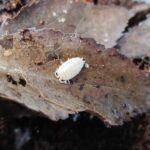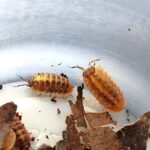
Porcellio laevis white
5,00€

Armadillidium vulgare "Mocca"
1,50€ – 6,00€Price range: 1,50€ through 6,00€
Cubaris sp. “White Side”
2,00€ – 8,00€Price range: 2,00€ through 8,00€
Discover the wonder of nature in your own home with the fascinating Cubaris “White Side” isopod! Bring a unique and exotic touch to your terrarium while enjoying its beauty and vital role in the ecosystem. Get yours today and immerse yourself in the world of biodiversity! 🌿✨
SKU:
N/A
Categories: Arthropods, Cubaris, Isopods
Description
Technical Data Sheet: Cubaris “White Side” Isopod
Scientific Name: Cubaris sp. “White Side”
Common Name: “White Side” Isopod
Taxonomic Classification:
- Kingdom: Animalia
- Phylum: Arthropoda
- Class: Malacostraca
- Order: Isopoda
- Family: Cubaridae
- Genus: Cubaris
- Species: sp. (unidentified species)
Description:
- Color: The “White Side” variety is characterized by having an opaque white color on the ventral side of its body, while the dorsal side may be white, grayish, or have brownish tones.
- Size: Adults typically measure between 3 and 5 mm in length.
- Shape: Oval-shaped and flattened dorsoventrally, with seven pairs of legs. It has a similar appearance to other isopods but with a distinctive color arrangement.
- Exoskeleton: Hard and segmented, providing protection and structural support to the isopod.
Distribution and Habitat:
- Distribution: This species is believed to be native to tropical or subtropical areas, although it has also been found in urban environments and terrariums in different parts of the world.
- Habitat: Prefers humid and dark environments, such as tropical forests, where it shelters under fallen leaves, decaying logs, and other plant debris.
Ecology and Behavior:
- Diet: Detritivore. It feeds mainly on decaying organic matter, such as dead leaves, rotten wood, and other plant debris.
- Behavior: Nocturnal and gregarious. Tends to gather in colonies and forage for food at night, while during the day it shelters in dark and humid places to avoid dehydration and predators.
- Reproduction: Ovoviviparous. Females carry eggs within a cavity in their body until they hatch, releasing offspring similar to adults but smaller.
Care in Captivity:
- Terrarium: A terrarium with humid substrate composed of soil, moss, and decaying leaves is recommended. It is important to maintain a high relative humidity to ensure the well-being of the isopods.
- Feeding: They can be fed a variety of fresh and decaying foods, such as fruits, vegetables, dried leaves, and decaying wood. Specific isopod dietary supplements can also be offered.
- Humidity and Temperature: Maintain a relative humidity of 70-80% and a temperature between 20-25°C for optimal breeding conditions.
Additional Observations:
- Coloration: The coloration of Cubaris “White Side” isopods may vary slightly between individuals and may influence their camouflage ability in their natural environment.
- Interaction with Other Organisms: They can be part of a balanced terrarium ecosystem, contributing to the decomposition cycle and maintaining soil quality.
Additional information
| Options |
1 unit ,5 units |
|---|
Related products
Creobroter gemmatus
10,00€ – 25,00€Price range: 10,00€ through 25,00€
Sold out
Descobreix el fascinant món de la Jewel Mantis: una criatura exòtica i enigmàtica que et convida a explorar el seu comportament únic. Submergeix-te en l'estudi del seu camuflatge, la seva agilitat en la caça i la seva bellesa captivadora. Una experiència que desperta la curiositat i et connecta amb la natura d'una manera inspiradora!
Select options
This product has multiple variants. The options may be chosen on the product page
Dola larvae (pachnoda)
5,00€
there is stock
Dola larvae (Pachnoda): the nutritious and easy-care solution for your pets! With their diet rich in fruits and vegetables, they are an excellent source of protein and contain virtually no fat ideal for ants, arthropods, reptiles and amphibians. Choose the best for your pets!!
Select options
This product has multiple variants. The options may be chosen on the product page
Gromphadorhina portentosa
1,50€ – 12,00€Price range: 1,50€ through 12,00€
there is stock
Discover the fascinating Madagascar hissing cockroach! Perfect as an exotic pet or for research projects. Its peculiarity and ease of care make it a unique choice. Dare to explore the world of these incredible creatures!
Select options
This product has multiple variants. The options may be chosen on the product page
Pseudoglomeris Magnifica
8,00€ – 60,00€Price range: 8,00€ through 60,00€
Sold out
Discover the stunning Emerald Cockroach (Pseudoglomeris Magnifica), its vibrant green color and unique presence make it a fascinating addition to any environment! Get yours now!
Select options
This product has multiple variants. The options may be chosen on the product page
Lucihormetica verrucosa
1,50€ – 10,00€Price range: 1,50€ through 10,00€
there is stock
Discover Lucihormetica verrucosa! Unique cockroach with green bioluminescence and warty exoskeleton. Perfect for studios or hobbyists.
Select options
This product has multiple variants. The options may be chosen on the product page
Stick insect (Medauroidea extradentata)
5,00€
Sold out
Common name: Stick insect Scientific name: Medauroidea extradentata Taxonomic classification: Kingdom: Animalia Phylum: Arthropoda Class: Insecta Order: Phasmatodea Family: Phasmatidae
Select options
This product has multiple variants. The options may be chosen on the product page
Armadillidium maculatum
2,50€ – 10,00€Price range: 2,50€ through 10,00€
there is stock
Select options
This product has multiple variants. The options may be chosen on the product page
























